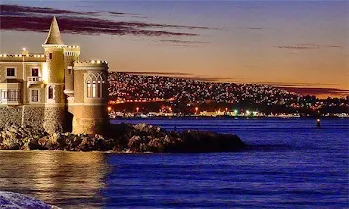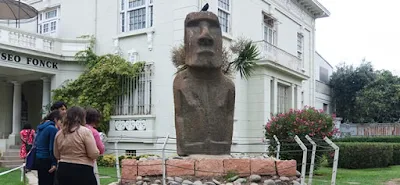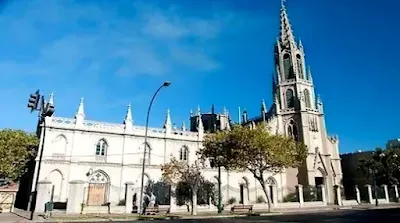- Get link
- Other Apps
Note: In February 2024, some places in central Chile suffered significant damage from devastating fires, including certain areas of Viña del Mar. Reconstruction will take a long time and tourism could be restricted in some spots.
______________
Viña del Mar (Vineyard of the Sea) or simply "Viña" for most of Chileans, is traditionally known as La Ciudad Jardin (Chile's Garden City). This resort city is located on the central coast of the country, 120 km. West of the capital Santiago and belongs to the Valparaiso Region.
By 2023 the estimated population is 360,000 people but together with Valparaiso and other neighboring municipalities make up an area of more than 1,000,000 inhabitants. Vina del Mar stands out for its cozy beaches, boulevards, large malls, good hotels and B&Bs, casino and various entertainment venues.
The city is also famous throughout Latin America for the Festival Internacional de la Cancion (International Song Festival), also known as the Festival de Viña, which has been held every year in February since 1959. The event is held in the Quinta Vergara, an amphitheater with a capacity of more than 15 thousand people, and since its creation, countless great artists have performed on its stage. Traditionally, the final day of the Festival de la Cancion de Vina del Mar marks the end of the holiday season for most vacationers, as the date generally coincides with the end of the hottest days of the summer and the return of students to classes.
Beaches of Viña del Mar
 |
| Repair jobs in Reñaca Beach - latercera.com |
As a result of climate change, the city's coastline has been affected by an increase in the frequency and intensity of extreme tidal surges.
The damage and erosion caused by these episodes have required permanent maintenance to counteract the effects and maintain the traditional quality of the beaches and surrounding infrastructure.
This is how Viña del Mar highlights beautiful beaches: Reñaca, Caleta Abarca, Acapulco and many others, all ideal for sunbathing and enjoying this part of the Pacific Ocean. Playa Reñaca, the epicenter of the summer activity of "Viña", along Borgoño Avenue, northern part of the city is visited by national and foreign tourists. With almost 1.5 km. of beach, Reñaca is one of the most important summer attractions in Chile, there is a number of hotels and on the hillsides, terraced apartment buildings overlook the Pacific Ocean.
Another of the most popular beaches of Viña del Mar is Caleta Abarca, the closest to the downtown, easily accesible, next to the beach, the Sheraton Miramar. Playa Acapulco (Acapulco beach), just steps from the city center is located this beach bearing the same name of the famous Mexican resort. Together with Reñaca, ranked one of the most visited of Viña del Mar, with a developed infrastructure, lots of restaurants, shopping centers and hotels in the nearby Avenida San Martin.
Cerro Castillo Presidential Palace
Address: 398, Callao Street. Neo-colonial mansion situated in the heart of Viña del Mar. Cerro Castillo (Castillo Hill) serves as the resting place for Chilean presidents. and occasionally works as an alternative seat of the Government Palace located in Santiago.
It was built between 1929 and 1930 in the place where was situated the old Fort Callao, which once protected the neighboring city of Valparaiso. Open to general public during the Dia del Patrimonio Cultural (Cultural Heritage Day) which is commemorated every year the last Sunday of May.
Castillo Wulff (Wulff Castle)
 |
| The Wulff Castle |
Castillo Brunet (Brunet Castle)
Address: 104 Iberia Street. Another construction that gives a distinctive stamp to Viña del Mar is Castillo Brunet, one of several castles that recall a time of economic splendor of the early twentieth century. Work of the renowned architects of the time Alfredo Azancot and Jorge Schroeder, it is located next to Cerro Castillo, overlooking the city center and the northern shore of Estero Marga Marga.The Brunet family began its construction in 1923 but the work did not end until it was sold to businessman Mr. Nicolas Yarur who gave it the current arabesque details. In 1974 the building was transferred to Carabineros de Chile who allocated the castle to their recreational and gastronomic area.
Castillo Ross (Ross Castle)
Address: 50, Marina Av. Today turned into the Club Union Arabe, is a replica of a nineteenth century Scottish residence, built in 1912 by the renowned architect Alberto Cruz Montt at the request of Gustavo Ross Santa Maria, politician and businessman of the time. Its architecture belongs to the medieval Tudor style, a design born in England during the sixteenth century and whose characteristics are based on sophistication and wealth. Its exterior stonework is outstanding. Inside, the building keeps original furniture and rooms, such as the old desks, bedroom and luxurious bathroom fully built in Carrara marble used by the former owner and his illustrious guests, including the Prince of Wales, who was here in 1925.
Castillo Ross (Ross Castle)
Address: 50, Marina Av. Today turned into the Club Union Arabe, is a replica of a nineteenth century Scottish residence, built in 1912 by the renowned architect Alberto Cruz Montt at the request of Gustavo Ross Santa Maria, politician and businessman of the time. Its architecture belongs to the medieval Tudor style, a design born in England during the sixteenth century and whose characteristics are based on sophistication and wealth. Its exterior stonework is outstanding. Inside, the building keeps original furniture and rooms, such as the old desks, bedroom and luxurious bathroom fully built in Carrara marble used by the former owner and his illustrious guests, including the Prince of Wales, who was here in 1925.
Palacio Vergara Museum
Palacio Vergara, a heritage building in the city of Viña del Mar, dating from 1910, reopened its doors to the public in December 2021, after major repairs and renovations that made it possible to restore the facilities from the serious damage it suffered during the earthquake of February 27, 2010.
This place could not fail to be mentioned, since for decades it has been one of the emblematic sites of Vina del Mar, located within the natural environment known as Quinta Vergara, next to Estero Marga Marga in the city center. The Quinta Vergara is also famous for being the place where for many years has been carried out the International Song Festival of Viña del Mar. Vergara Palace was built between 1906 and 1910 as a residence for the family of Jose Francisco Vergara, one of the founders of the garden city.
Francisco Fonck Museum
 |
| Image: Municipalidad Viña del Mar |
The archaeological heritage of Fonck Museum is made up of several collections, highlighting objects from native cultures from Chile, Peru and Ecuador, as well as a Natural History section. It also exhibits more than 1,400 pieces of archaeological and ethnographic objects on Rapa Nui (Easter Island), the most complete sample of the Rapa Nui culture existing in continental Chile. More information about Fonck Museum at Museums of Viña del Mar.
Address: #784, 4 Norte St., Viña del Mar.
Date of foundation: November, 1937.
Date of foundation: November, 1937.
Open:
Monday 10:00 - 14:00 hrs. and from 15:00 to 18:00 hours
Tuesday to Saturday 10:00 - 18:00 hrs.
Sunday and Holidays 10:00 - 14:00 hrs.
Reloj de Flores (Flower Clock)
Traditional postcard of Viña del Mar, at the foot of Cerro Castillo, in front of Caleta Abarca beach. It was installed in 1962, when the city was one of the venues for the FIFA World Cup held in Chile during that year.
The current GPS controlled mechanism, also includes ringing and melodies digitally programmed, changing according to the seasons and important days to celebrate.
Jardin Botanico Nacional de Viña del Mar
Address: 305, Camino El Olivar, El Salto. One of the most important green areas of Vina del Mar, located in El Salto, SE of the city, with a total of 395 hectares of native and exotic plants that make it an excellent choice for a walk in the nature. It is also known as "Parque del Salitre" ("Saltpeter Park") given that its creator was Pascual Baburizza, businessman of Croatian origin who, among other activities, engaged with the trade of nitrate industry in the early decades of the 1900s. In fact, of the current area open to the visitors, there are 22 hectares belonging to the former park built by Baburizza in 1918, the National Botanic Garden itself was created in 1951 when the original Parque del Salitre, was donated to the state of Chile.
The park contains more than 3,000 plant species of all types, a large number of trees and a palm grove, plus a pool with a walkway ending in a trail in the woods.
Iglesia de Los Carmelitas
 |
| Image: Obispado de Valparaiso |
Address: 391 Libertad Ave., this gothic style catholic church inaugurated in 1926, is another place worth visiting in Viña del Mar. The Sanctuary is a place of worship and prayer, but it is also frequented by tourists who appreciate its architectural beauty and significant artistic and religious details.
Throughout its history, it has been affected by strong earthquakes. In 1906, the original chapel was destroyed by a major seism. In 1985 and 2010, other severe earthquakes seriously damaged the current structure, important repairs were necessary to recover the building's structure. Iglesia de los Carmelitas is a place of great importance for the local Catholic community and is often used for religious celebrations and weddings.
Muelle Vergara
Avenida Perú
Avenida Peru is another of the points of interest in Viña del Mar. It is a pedestrian promenade that borders the Pacific Ocean offering a beautiful view of the sea. Along the avenue, there are spaces for the recreation of children and adults, such as playgrounds, green areas and benches. In addition, you can find various tourist services, such as restaurants, hotels and attractive commercial establishments.
Avenida Perú has a rich history that dates back to the 19th century and has evolved to become an important tourist destination in the city. In short, Avenida Perú is an ideal place to enjoy nature, culture, entertainment and the history of Viña del Mar.
Museums in Viña del Mar
* Museo Francisco Fonck, # 784, 4 Norte st., with a collection of archaeological, ethnographic and paleontological objects. One of its main attractions is the exhibition of an authentic Moai from Easter Island. See more information above.
* Museo Palacio Vergara, # 563 Errazuriz st., inside the Quinta Vergara urban park, the museum houses a variety of temporary and permanent exhibitions, displaying works by Chilean and foreign artists. In addition, the Palacio Vergara itself is a notable architectural attraction, with beautiful gardens surrounding the property. It reopened its doors at the end of 2021 after almost 12 years of being closed due to serious damages caused by the strong earthquake of 2010.
* Museo de Artes Decorativas Palacio Rioja, # 214 Quillota st., the gallery is located in a beautiful historic palace and exhibits a collection of furniture, decorative objects and art related to the history of Viña del Mar and the aristocracy of the time. In 1985, the residence, together with its surrounding park were declared a National Historical Monument.
* Museo Artequin, # 500 Alcalde Prieto Nieto inside the Quinta Vergara Park, this museum focuses on art education and offers interactive exhibits that allow visitors to learn about different artistic currents and famous painters.
* Museo de Historia Natural de Valparaíso, # 1546 Condell st., although not exactly in Viña del Mar, it is in the neighboring city of Valparaíso and is well worth a visit. This museum has a large collection with exhibits of Chilean flora and fauna, as well as samples of geology and paleontology.
* Museo Naval y Marítimo, # 45 Paseo 21 de Mayo, also located in the neighboring city of Valparaíso, this museum focuses on Chile's rich naval history and features a number of naval-related objects.
- Get link
- Other Apps



Comments
Post a Comment